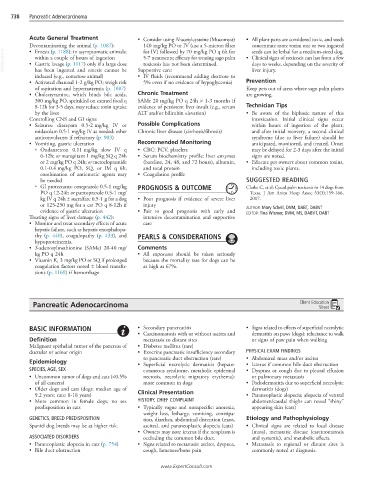Page 1453 - Cote clinical veterinary advisor dogs and cats 4th
P. 1453
738 Pancreatic Adenocarcinoma
Acute General Treatment • Consider using N-acetylcysteine (Mucomyst) • All plant parts are considered toxic, and seeds
Decontaminating the animal (p. 1087): 140 mg/kg PO or IV (use a 5-micron filter concentrate more toxin; one or two ingested
VetBooks.ir • Gastric lavage (p. 1117) only if a large dose 5-7 treatments; efficacy for treating sago palm • Clinical signs of toxicosis can last from a few
seeds can be lethal for a medium-sized dog.
for IV) followed by 70 mg/kg PO q 6h for
• Emesis (p. 1188): in asymptomatic animals;
within a couple of hours of ingestion
toxicosis has not been determined.
days to weeks, depending on the severity of
has been ingested and emesis cannot be
induced (e.g., comatose animal) Supportive care: liver injury.
• IV fluids (recommend adding dextrose to
• Activated charcoal 1-2 g/kg PO; weigh risk 5% even if no evidence of hypoglycemia) Prevention
of aspiration and hypernatremia (p. 1087) Keep pets out of areas where sago palm plants
• Cholestyramine, which binds bile acids, Chronic Treatment are growing.
300 mg/kg PO, sprinkled on canned food q SAMe 20 mg/kg PO q 24h × 1-3 months if
8-12h for 3-5 days, may reduce toxin uptake evidence of persistent liver insult (e.g., serum Technician Tips
by the liver ALT and/or bilirubin elevation) • Be aware of the biphasic nature of this
Controlling CNS and GI signs: intoxication. Initial clinical signs occur
• Seizures: diazepam 0.5-2 mg/kg IV or Possible Complications within hours of ingestion of the plant,
midazolam 0.5-1 mg/kg IV as needed; other Chronic liver disease (cirrhosis/fibrosis) and after initial recovery, a second clinical
anticonvulsants if refractory (p. 903) syndrome (due to liver failure) should be
• Vomiting, gastric ulceration Recommended Monitoring anticipated, monitored, and treated. Onset
○ Ondansetron 0.11 mg/kg slow IV q • CBC: PCV, platelets may be delayed for 2-3 days after the initial
6-12h; or maropitant 1 mg/kg SQ q 24h • Serum biochemistry profile: liver enzymes signs are noted.
or 2 mg/kg PO q 24h; or metoclopramide (baseline, 24, 48, and 72 hours), albumin, • Educate pet owners about common toxins,
0.1-0.4 mg/kg PO, SQ, or IM q 6h; and total protein including toxic plants.
combination of antiemetic agents may • Coagulation profile
be needed SUGGESTED READING
○ GI protectants: omeprazole 0.5-1 mg/kg PROGNOSIS & OUTCOME Clarke C, et al: Cycad palm toxicosis in 14 dogs from
PO q 12-24h or pantoprazole 0.5-1 mg/ Texas. J Am Anim Hosp Assoc 53(3):159-166,
kg IV q 24h ± sucralfate 0.5-1 g for a dog • Poor prognosis if evidence of severe liver 2017.
or 125-250 mg for a cat PO q 8-12h if injury AUTHOR: Mary Schell, DVM, DABT, DABVT
evidence of gastric ulceration • Fair to good prognosis with early and EDITOR: Tina Wismer, DVM, MS, DABVT, DABT
Treating signs of liver damage (p. 442): intensive decontamination and supportive
• Monitor and treat secondary effects of acute care
hepatic failure, such as hepatic encephalopa-
thy (p. 440), coagulopathy (p. 433), and PEARLS & CONSIDERATIONS
hypoproteinemia.
• S-adenosylmethionine (SAMe) 20-40 mg/ Comments
kg PO q 24h • All exposures should be taken seriously
• Vitamin K 1 3 mg/kg PO or SQ if prolonged because the mortality rate for dogs can be
coagulation factors noted ± blood transfu- as high as 67%.
sions (p. 1169) if hemorrhage
Pancreatic Adenocarcinoma Client Education
Sheet
BASIC INFORMATION • Secondary pancreatitis • Signs related to effects of superficial necrolytic
• Carcinomatosis with or without ascites and dermatitis on paws (dogs): reluctance to walk
Definition metastasis to distant sites or signs of paw pain when walking
Malignant epithelial tumor of the pancreas of • Diabetes mellitus (rare)
ductular or acinar origin • Exocrine pancreatic insufficiency secondary PHYSICAL EXAM FINDINGS
to pancreatic duct obstruction (rare) • Abdominal mass and/or ascites
Epidemiology • Superficial necrolytic dermatitis (hepato- • Icterus if common bile duct obstruction
SPECIES, AGE, SEX cutaneous syndrome, metabolic epidermal • Dyspnea or cough due to pleural effusion
• Uncommon tumor of dogs and cats (<0.5% necrosis, necrolytic migratory erythema): or pulmonary metastasis
of all cancers) more common in dogs • Pododermatitis due to superficial necrolytic
• Older dogs and cats (dogs: median age of Clinical Presentation dermatitis (dogs)
9.2 years; cats: 8-18 years) • Paraneoplastic alopecia; alopecia of ventral
• More common in female dogs; no sex HISTORY, CHIEF COMPLAINT abdomen/caudal thighs can reveal “shiny”
predisposition in cats • Typically vague and nonspecific: anorexia, appearing skin (cats)
weight loss, lethargy, vomiting, constipa-
GENETICS, BREED PREDISPOSITION tion, diarrhea, abdominal distention (mass, Etiology and Pathophysiology
Spaniel dog breeds may be at higher risk. ascites), and paraneoplastic alopecia (cats) • Clinical signs are related to local disease
• Owners may note icterus if the neoplasm is (mass), metastatic disease (carcinomatosis
ASSOCIATED DISORDERS occluding the common bile duct. and systemic), and metabolic effects.
• Paraneoplastic alopecia in cats (p. 754) • Signs related to metastasis: ascites, dyspnea, • Metastasis to regional or distant sites is
• Bile duct obstruction cough, lameness/bone pain commonly noted at diagnosis.
www.ExpertConsult.com

